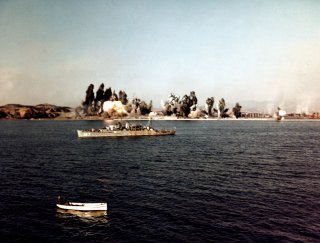Christmas Miracle at Hungnam: The Epic Evacuation that Changed Korea Forever
Until the U.S. evacuation from Afghanistan this summer, this was estimated to be the largest wartime evacuation of civilians undertaken by the U.S. military, and it dramatically affected the lives of at least a million Koreans today.
But alongside the soldiers, tanks and ammunition were 91,000 civilians (or 98,000, counting those evacuated at Wonsan) crammed in unbelievable numbers on ships designed for a fraction of that total. For example, LST 661 and 668—designed to carry 150 soldiers—carried 9,400 and 10,500 persons respectively.
But the top carrier was the 450-foot-long Victory-ship Meredith Victory. Her captain, Leonard Larue (who later became a Benedictine monk) ditched cargo to maximize passenger capacity, assembling 16 persons at a time on a pallet for depositing into the ship’s five cargo holds by crane, cramming in 14,500 people in 26 hours of loading.
The overloaded freighter then made the 28-hour journey to Pusan on the southeastern tip of the Korean peninsula on a ship without interpreters, sanitation, or medical facilities. LaRue later recalled in an interview “I cannot possibly describe the nightmarish quality of that journey. We had no food and almost no water for the refugees—they ate only what they could bring aboard. There were no extra blankets, no clothing to warm them.”
At one point refugees attempting to build a fire for heating on top of stowed fuel drums had to be dissuaded via frantic hand gestures by the crew. Furthermore, women gave birth to five children on the freighter who were dubbed Kim-Chi One through Kim Chi Five by the crew. Lacking medical instruments, a midwife on board reportedly cut an umbilical cord using her teeth.
But when Meredith arrived at Pusan, the overwhelmed port authorities denied them permission to disembark! Instead, the cargo ship was redirected to Koje-Do island, though at least some interpreters came onboard to calm the passengers. Finally, after three nights at sea, Navy LSTs pulled up along both sides of Meredith and finally brought the refugees to shore—fortunately all of whom survived.
Sadly, tens of thousands of would-be evacuees did not make it onto a boat and were forced to risk overland flight or retribution from North Korean authorities.
Doyle wrote, “Had there been sufficient shipping, twice that (number) could have been saved. For when the last ship sailed, I estimated that as many Koreans remained (behind), vainly hoping for transport.” North Korean accounts also claim refugees were killed in the demolition of the port.
Today, it’s estimated there are around one million South Korean citizens—or nearly two percent of the population are descended like president Moon Jae-in from the refugees evacuated at Hungnam and Wonsan.
Saving those people by far exceeded Almond’s orders but he recognized he had the capacity to do so, and men like Hyun Bong-Hak, Admiral Doyle, Col. Forney, and captain Larue had the grit and skill to make it happen while under seemingly intolerable stress. Their actions and those of the refugees they aided continue to redound into the present day and beyond.
Sébastien Roblin holds a Master’s Degree in Conflict Resolution from Georgetown University and served as a university instructor for the Peace Corps in China. He has also worked in education, editing, and refugee resettlement in France and the United States.
Image: Wikimedia Commons

